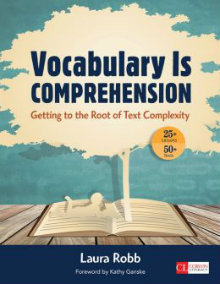Vocabulary Lessons to Boost Comprehension
Vocabulary Is Comprehension: Getting to the Root of Text Complexity
By Laura Robb
(Corwin Literacy, 2014 – Learn more)
 Reviewed by Cindi Syverson
Reviewed by Cindi Syverson
In Vocabulary Is Comprehension, Laura Robb has created a “game plan that is systematic and doable for teachers who are already overloaded.” (p. 1)
Chapter 1, “How the Common Core Has Changed the Rules of the Game Forever (Even If the Standards Go Away),” gives the history of how this book came to be. Teachers know there is a strong relationship between reading comprehension and word knowledge. Robb’s goal is to help teachers help students better understand complex texts through vocabulary studies.
The lessons are created for teachers to devote 10-15 minutes a day on word learning that relates to Tier Two words (general academic vocabulary) and Tier Three words (domain specific vocabulary). The author uses the Big 10 Approach to Reading Words Closely:
 #1 Promote Meaningful Talk
#1 Promote Meaningful Talk
#2 Study Word Parts: Roots, Prefixes, Suffixes
#3 Attend to Figurative Language and Connotation
#4 Situate Words in Various Contexts
#5 Use New Vocabulary in Writing
#6 Build Concepts
#7 Make Connections
#8 Tap Into Technology
#9 Promote Independent Reading
#10 Deliver Daily Read-Alouds
Chapters 2-6 share lessons and strategies that address the Common Core and the Big 10 Approach to Reading Words Closely. The lesson format involves sharing a short complex text and connecting the word learning and comprehension.
A variety of texts are available online through the Corwin publisher’s link for teachers to use in whole group or to have students read independently. Then there is small group discussion to rehearse the words to ensure understanding before moving on to a student reproducible to be completed together, as homework, or as a review the next day.
Each lesson also has a “How I Might Follow Up This Lesson” section with suggestions on extending the learning or providing short interventions to assist students to move forward with vocabulary. These lessons provide the teacher with a springboard to make other lessons of their own, based on their students’ specific needs and interests.
Each lesson also contains tips for English Language Learners and Developing Readers (readers who are below grade level). Most lessons have examples of completed student work to give the teacher a work sample at various grade levels.
The easy access to the online resources enhances the usefulness to teachers. If students have iPads or other technology, they could annotate using Notability or a similar application. The variety and quality of resources makes the book a pleasure for a novice or a veteran teacher to use.
I would recommend this book to teachers who are looking for real text for students to read to build vocabulary. The lesson format, I think, could be fit into your existing class period since it is 10-15 minutes a day over three days.
Cindi Syverson is a 6th grade English Language Arts teacher in Wisconsin. She just completed her 21st year of teaching. She taught LD/ED for four years, 4th grade for one year, 5th grade for ten years, 1st grade for three years, 5th grade again for two years–all in elementary schools. She just finished her second year of 6th grade in a middle school setting. Her Masters is in Guidance and Counseling PK-12.
































